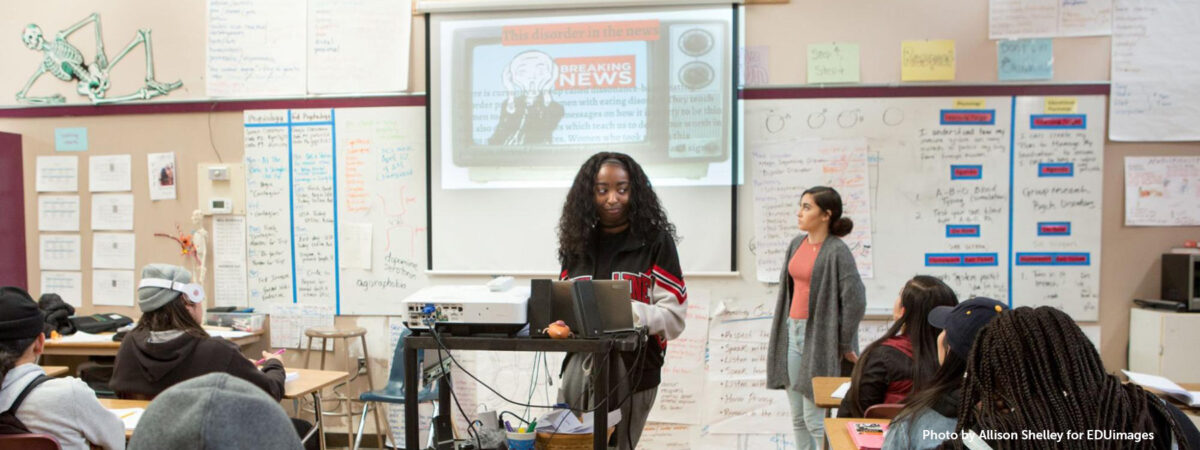
The Inclusive Innovation process is a transformational framework that facilitates growth with equity in a unified way through a student, community, and educator-led research and design process. As part of the Inclusive Innovation process, we created a team consisting of students, district administration, teachers, members from local community organizations, and the Center for Inclusive Innovation team members. This team aimed to create a solution for an equity-related problem occurring in the community. Also included in this process were parents, district retirees, religious leaders, and other school staff. Through the five-step Inclusive Innovation process, we intentionally ensured the group was diverse and representative of the community. This was important for me because when people are excluded, everyone involved misses out on the opportunity to gain insight into enlightening perspectives.

The Inclusive Innovation diagram shows the five phases at the top which include Connect and Commit, Inquire and Investigate, Design and Develop, Implement and Iterate, and Sustain and Scale. At the bottom, the equity first practices are listed which include: engagement, capacity building, reflection and recognition.
The Connect and Commit stage was invaluable, as it welcomed the opportunity for us to learn about each other. I had previously met Damita Harvey, a team member and community leader, through a district equity initiative a few years ago, but this endeavor enabled us to get to know each other even more. Connecting also allowed participants to embrace the idea that we are experts when it comes to our life experiences—context experts. Because of that, we were able to move through the process with an appreciation of each other’s perspectives, instead of feeling like we were working to address one narrative.
The next stage was Inquire and Investigate, where we investigated the challenge by conducting research. Without navigating through this stage as a team, it would not have been easy to plan one focus group, let alone several. Multiple focus groups were facilitated with teachers sharing their experiences, students speaking out about what they’ve felt and witnessed, former students sharing their stories, and everyone trusting that the process would lead to positive change in the future. Participants appreciated the opportunity to join the focus groups so much that it was sometimes difficult to end the sessions. I loved it!
During the Design and Develop stage, we reviewed data and prioritized ideas while placing an emphasis on the students’ thoughts and feelings. As an educator, I have always believed my actions were student-centered, but this process enabled the students to speak up for themselves. No interpretation from me was needed, because our students have voices and they need to be heard! The solution turned out to be a synthesis of the ideas shared along the way. When thinking of inclusion, this was it. Students, educators, and community members decided to create student-led professional development (PD) that would educate teachers on the racialized experiences students face at school and how it impacts their mental health. We formed a leadership group that helped prepare the students.
Students have now led PD for educators at two professional development days. Teachers have praised the students’ ability to speak so openly about their experiences, and multiple attendees have stated that this was the most impactful PD they’d ever experienced. Without district administration prioritizing the need for our students’ to share their stories, we would not have had the time or space to facilitate the student-led PD. Public speaking, especially in front of authority figures, was anxiety-inducing for some of the students, so having an audience of educators eager to hear stories and action-plan with students helped immensely.
“I’ve been a teacher for 27 years. I’ve probably been to over 100 workshops. Today’s [PD] was by far the most rewarding and beneficial one I’ve ever been to. I literally had goosebumps listening to our amazing students’ stories about the negative experiences they’ve endured. That was no easy undertaking and they did a fantastic job reflecting on those unfortunate experiences. I want to thank you for everything you have done with this group and the unforgettable experience I had today. Keep up the great work in making the world a better place!” – BTSD Teacher
Without collaboration, not a single session would have occurred. Because we intentionally fostered collaboration and inclusion,our students have facilitated multiple PD sessions, and they are excited to do more in order to improve their learning community. In order to be compassionate and impactful educators, we must nurture safe and trusting relationships with our students. Providing opportunities for them to share their experiences and communicate their needs is a meaningful way to build trusting relationships. Be intentional about amplifying and valuing student voices, and collaborate with them to identify solutions.
Listen to them. Believe them. Respect them.
To learn more, explore the resources below: